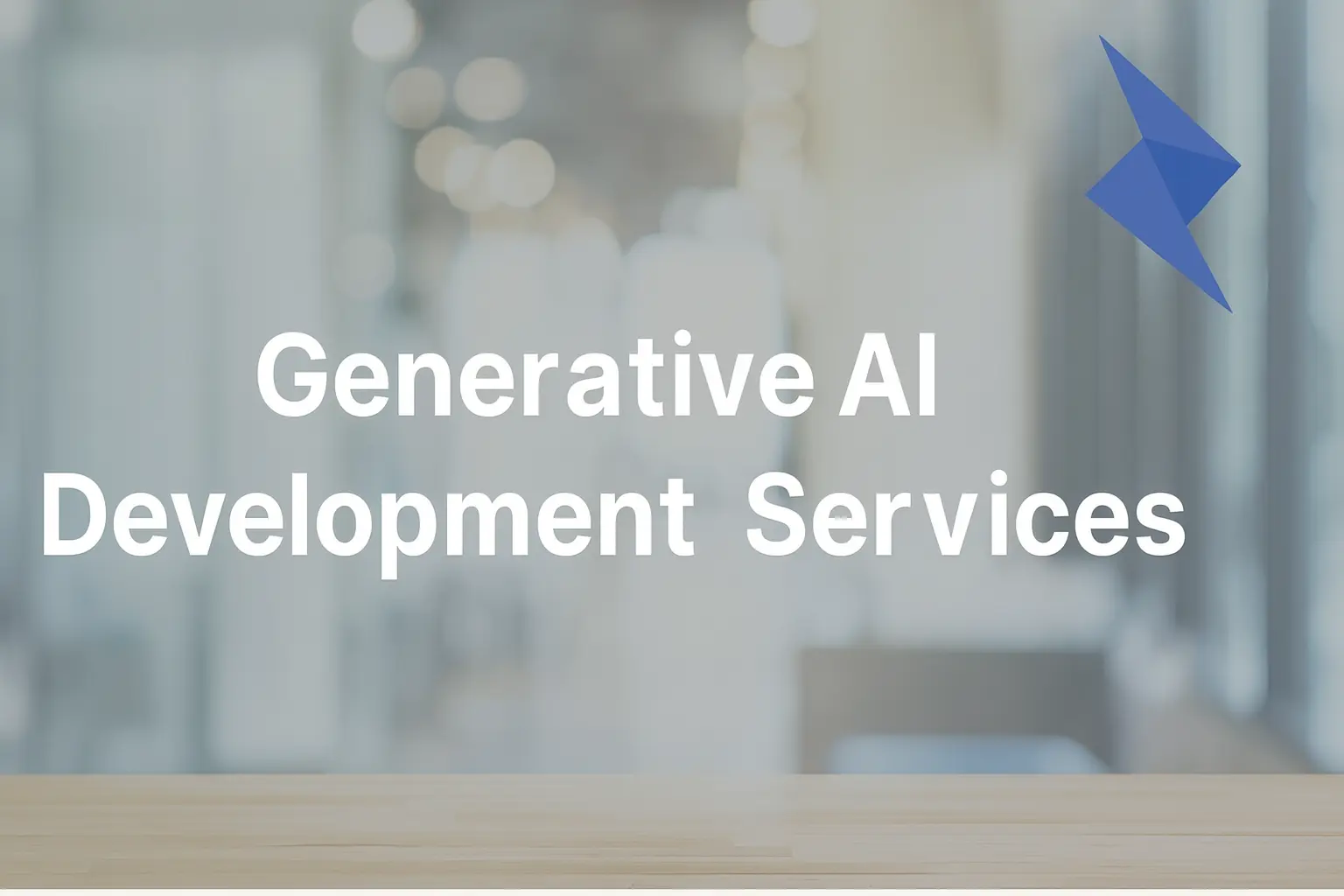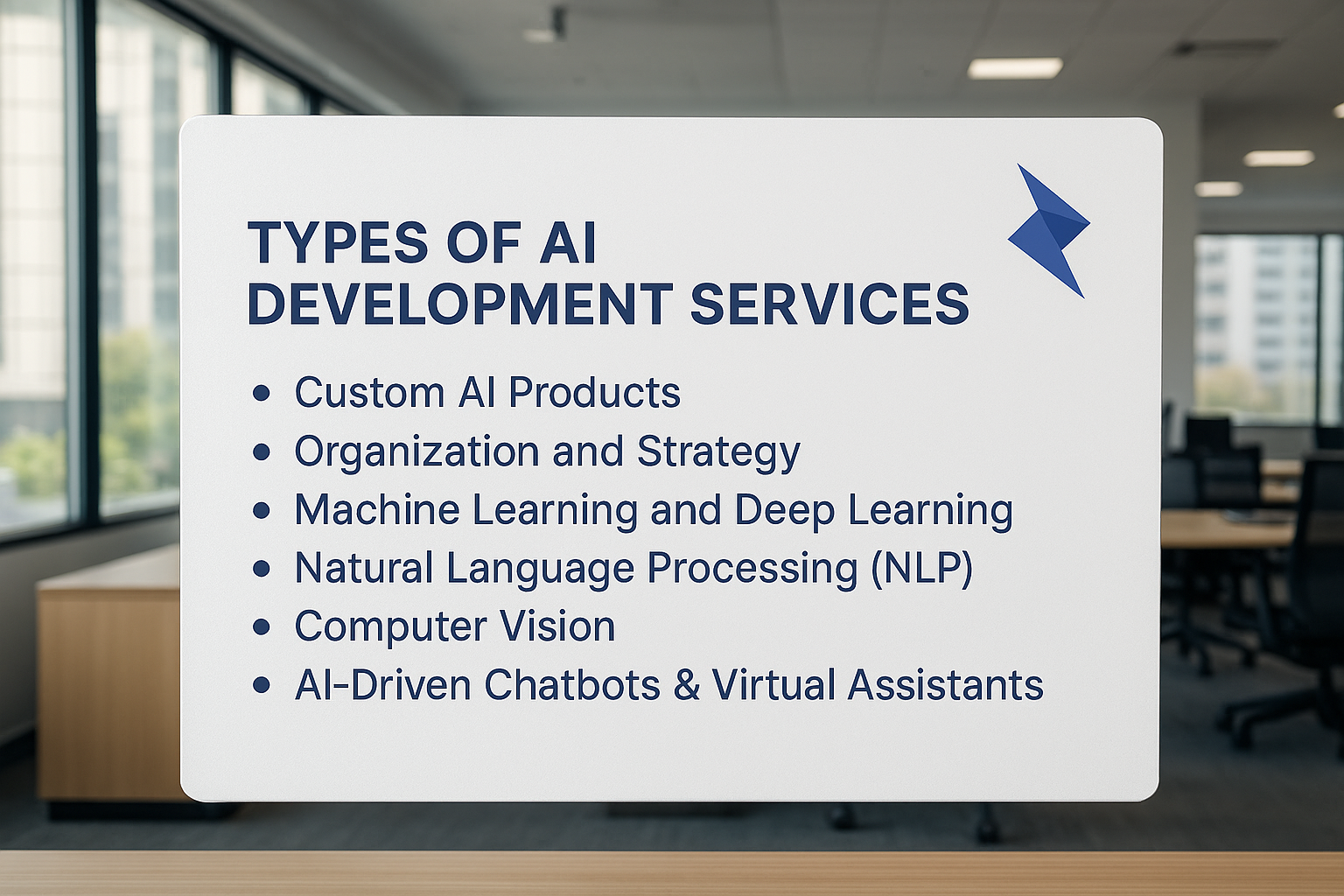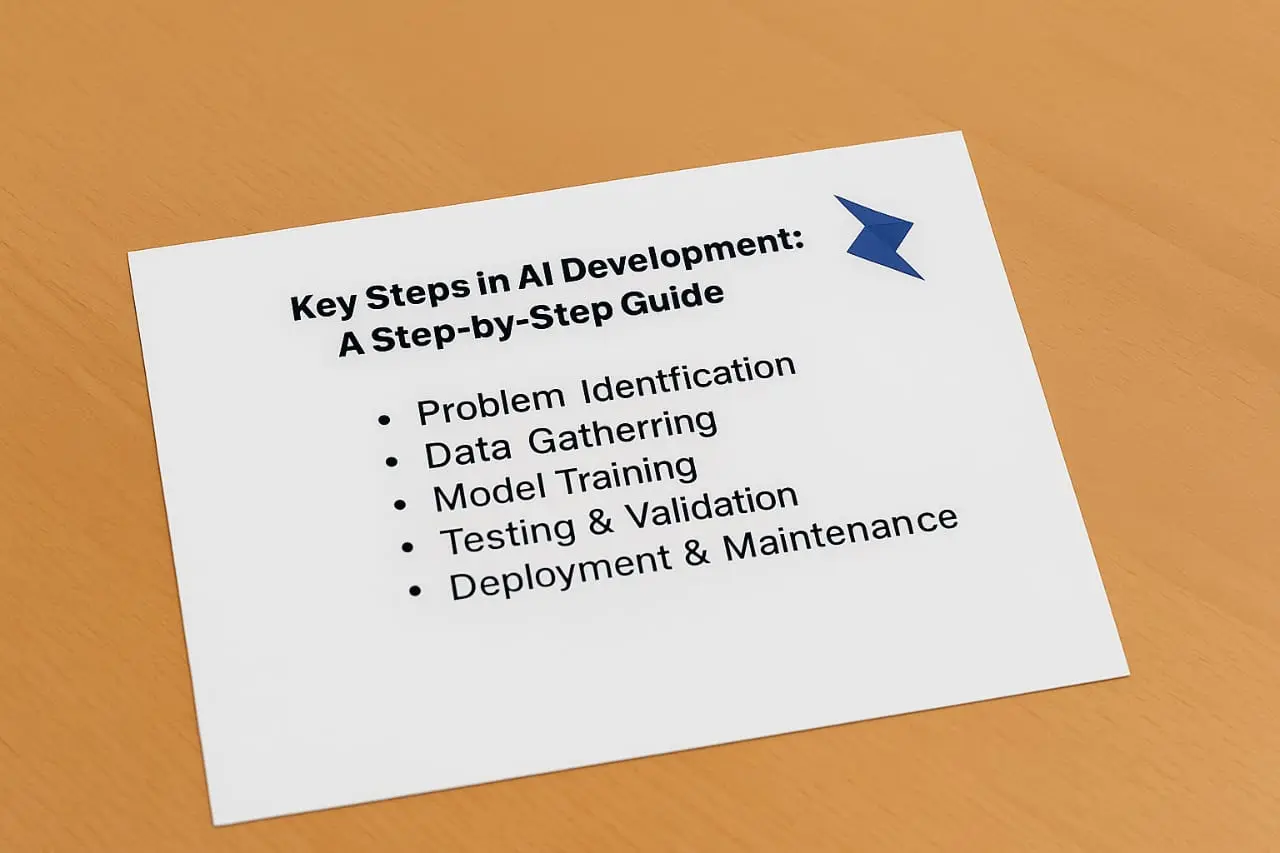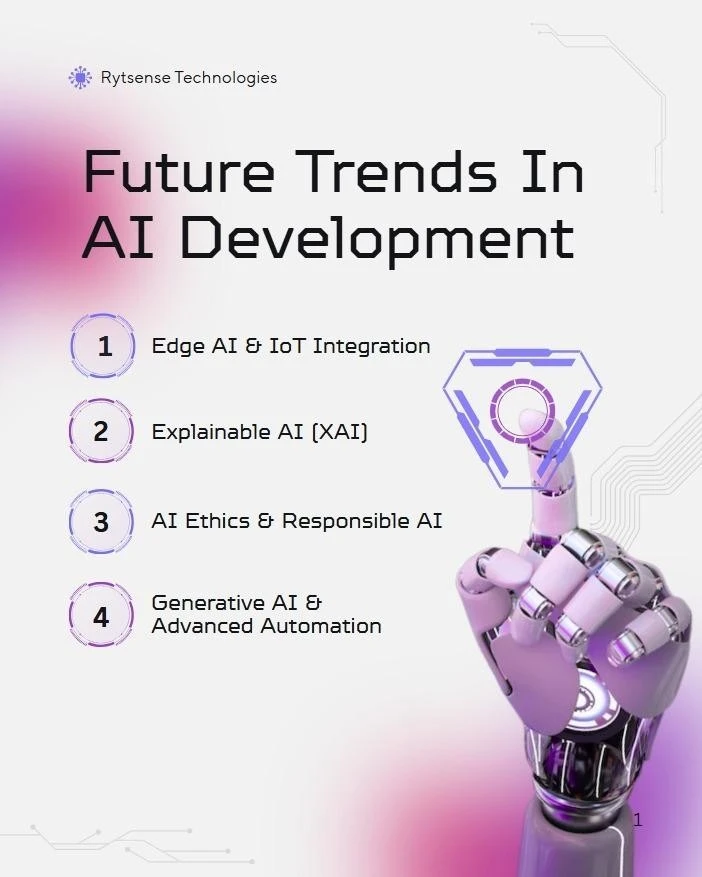What Are AI Development Services?
AI development services include:
- Machine Learning & Deep Learning—Designing predictive models that learn from the data.
- Natural Language Processing (NLP)—Interactions with texts and speech that feel human-like.
- Computer Vision—Deriving insight from images or video feeds.
- Generative AI—dependently generating original content, designs, and solutions.
- AI Integration – Incorporating intelligence into existing workflows seamlessly.
For enterprises seeking innovation, partnering with a custom AI development company provides specialised knowledge converting raw data into business value.

The Growing Importance of AI in Business
-
Intelligent Automation
- Reduce operational costs by 30-50% using AI process automation
- Eliminate repetitive manual tasks through self-learning workflows
-
Data-Driven Decision-Making
- Use predictive analytics for accurate demand forecasting and risk analysis
- Capture real-time insight from unstructured data sources
-
Improved Customer Experience
- Implement AI chatbots with automated text responses that address 80% of routine customer questions
- Provide hyper-personalised recommendations by analysing behaviour
-
Competitive Differentiation
- Early adopters of AI might increase their market share by 20% to 30%
- Continue to innovate with evolving adaptive machine learning models
For businesses wishing to future-proof their operations, partnering with an experienced AI development company in the USA will provide
✔ AI knowledge specific to a domain
✔ Established implementation processes
✔ Scaled enterprise solutions
✔ Continued support
The strategic use of generative AI development services can be truly transformative in the following ways for businesses:
- Automate social media and content generation on a large scale
- Decrease product cycles by increasing design proficiencies
- Improve authorship and creative workflows
- Implement intelligent virtual assistants for schedule management
Ready to turn your data into decisions? Our AI experts are here to help.

Types of AI Development Services

Custom AI Products
Common Applications:
- Detection—AI models explore transactional behaviour and flag suspicious activity as soon as it occurs.
- Predictive Maintenance—AI greatly reduces downtime in manufacturing by predicting equipment failure.
- Customer Targeting—AI-based recommendations make customer targeting more effective.
Top AI development firms will create solutions specifically tailored to your requirements.
Read Latest ai development you should know
Organization and Strategy
- Identifying use cases for AI with the most impact
- Determining if the infrastructure and data are prepared for deployment
- Creating a phased implementation plan
- Identifying how to measure ROI and performance benchmarks.
Reason this is important:
- 60% of AI projects fail because of poor planning (Gartner).
- An AI strategy structure increases the likelihood of success 3x.
Machine Learning and Deep Learning
Key Use Cases:
- Customer Churn Prediction—Recognize customers who may leave your customer base before they leave.
- Autonomous Systems—Self-learning robots in logistics and manufacturing.
- Medical Diagnosis—AI models recognize diseases from X-rays and scans with great accuracy.
As a top AI development company in the USA, we're able to develop ML/DL models that grow with the needs of your business.
Natural Language Processing (NLP)
- NLP makes it possible for machines to comprehend, decipher, and produce human language.
- It motivates: 80% of consumer inquiries are answered by AI chatbots without the need for human assistance.
- Sentiment Analysis—you can source brand perception from social media posts.
- Document Summarization—translates a 300-page report to 1-page summary files instantly.
Development services in generative AI can enhance natural language processing so developers can build ChatGPT-like conversational agents.
Computer Vision
- Retail—cashier-less checkout system (Amazon Go)
- Healthcare—AI-assisted radiologists for more rapidly and efficiently providing diagnoses.
- Manufacturing—able to address defect detection across production lines.
Predictive Analytics
- Sales Force—better inventory decisions for businesses based on possible demand forecasting
- Risk Assessment—Big banks and financial institutions use AI to assess loan applications.
- Supply Chain Optimization: AI is capable of precisely forecasting delays and suggesting substitutes.
AI-Driven Chatbots & Virtual Assistants
- Multilingual—Provides support for global audiences.
- Easy Consistency with CRM—Easily associating conversations with customer profiles.
Unlock smarter automation, faster innovation, and personalized experiences with generative AI.

AI Integration into Current Systems
- ERP & CRM—Salesforce, SAP
- Legacy systems—mainframe modernization
- Cloud—AWS, Azure, and GCP
Visit Best generative AI development company
Industries Disrupted by AI Development Services
Healthcare
Some Key Use Cases:
- AI Diagnostics—Machine learning can analyze a medical image (x-ray, MRI) with greater than 95% accuracy to identify tumors, fractures, and diseases much earlier than traditional methods.
- Drug Discovery—Now with generative AI models, pharmaceutical research will happen in half the time (why wait years when it can be a few months?).
- Patient Monitoring—Wearable AI allows for real-time vital sign monitoring and alerts doctors of potential emergencies.
- Personalized Medicine—AI evaluates genetic data and offers tailored treatment plans
Why Work with a Custom AI Development Company? Healthcare needs AI solutions that are HIPAA compliant, secure, and integrated with EHR systems. As a firm that builds AI software, our services meet regulatory requirements while improving patient outcomes.
Finance & Banking
Transformed Use Cases:
- Fraud Prevention—AI allows for real-time analysis of transaction patterns, potentially shrinking losses due to fraudulent activities by 50%.
- Algorithmic trading—With machine learning in AI, market predictions become possible, allowing trades to be made more intelligently based on trends.
- Credit Scoring (Risk Assessment)—AI is changing how we evaluate and assess risk in lending. In fact, they are outperforming traditional models, such as FICO credit scores.
- Chatbot Banking—Virtual assistants powered by generative AI now allow institutions to handle upwards of 80% of customer inquiries without an agent.
Retail & E-Commerce
AI-Powered Possibilities:
- Personalised shopping = product recommendations—AI analyses browsing history to make product recommendations and sees a conversion increase of 30%. Fewer items are abandoned in carts, e-commerce tech, and for those that do abandon the cart, the items left behind represent fewer units of inventory being sent to liquidation.
- Dynadynamic machine learning pricing that takes competition and demand into account.
- Machine learning pricing opportunistically while considering demand and competition.
- Visual Search—Customers use photos taken with their phones to search, find, and buy matching products within seconds.
- Generative AI for Content—Automatically generates product descriptions, advertisements, and marketing content.
Manufacturing
Applications of AI in Industry 4.0:
- Predictive Maintenance—Sensors + AI anticipate equipment failure ahead of time, resulting in 40% less downtime.
- Defect Detection—Computer vision analyses finished products at 99.9% accuracy, reducing overproduction waste.
- Supply Chain Optimisation—Predictive analytics enables AI to forecast the right material counts and automate acquisition of resources.
- Generative AI for Design—Automates the prototyping process of designs and finished product performance.
Logistics & Supply Chain
Exciting Uses of AI in Logistics:
- Route Optimisation—Informs fuel efficiencies up to 15% by calculating delivery routes according to the most effective and shortest path.
- Autonomous Robots in Warehouses—AI-powered robots fulfil orders 3x quicker than humans can pick & pack.
- Demand Forecasting—Predicts inventory needs with 90%+ accuracy, avoiding stockouts.
Marketing & Advertising
AI Marketing Tools:
- Programmatic Ad Buying—AI automatically buys ad space at the best price.
- Customer Segmentation—Machine learning identifies groups of customers that could turn into high-value customers.
- Generative AI Content Creation—Creates blog posts, social media captions, and ads in seconds.
- Sentiment Analysis—Tracks consumer opinion about a brand on social media.
Key Steps in AI Development: A Step-by-Step Guide

Problem Identification
- Requirement Analysis—Engage stakeholders to discuss pain points
- Feasibility Analysis—Determine if AI is the appropriate solution
- Success Measurement—Clearly define Key Performance Indicators (KPIs) - (accuracy levels, cost savings, etc.)
Generative AI-specific considerations:
- Are we looking to produce content, automate a process, or expand datasets?
- What kind of outputs do we expect the model to produce (text, images, code)?
Why Does This Matter?
- 42% of AI failures are attributed to poorly defined goals and objectives. (MIT Sloan)
- Clearly framing the problem decreases the costs of development by 30%.
DataRobot
Data Gathering
Must-Dos:
- Data Discovery—Identify available structured/unstructured data that is relevant
- Data Cleaning—Look for missing values, outliers, and other inconsistencies in the data
- Data Labeling—Annotate the data for supervised learning
- Privacy Requirements—follows GDPR/HIPAA regulations
Generative AI Data Requirements:
- A large, uniquely diverse dataset for training (e.g., for LLMs, millions of text examples)
- A specific data set for fine-tuning (e.g., specific to a use case/industry or professional discipline type of custom models and solutions)
Our custom AI development company's value proposition to you:
- Proprietary data collection pipelines
- Advanced synthetic data generation when real data is not available
Model Training
- Algorithm Selection—Given the choice of CNN, RNN, GAN, or Transformer architectures
- Feature Engineering—Being able to pull meaningful patterns from the data
- Hyperparameter Tuning: Optimizing performance of the model
Focus of generative AI development services:
- Specific architectures such as text GPT and Stable Diffusion (images)
- Fine-tuning pre-trained models for domain-specific use cases
The goals for performance benchmarks are
- Achieving >90% accuracy for most classification tasks
- Producing material of human quality with an error rate of less than 5%
Testing & Validation
- Accuracy Testing: performing accuracy benchmarking against validation datasets
- Bias Testing—Identify algorithmic biases and any mitigation required
- Stress Testing—Identify performance limits at peak demands
- Explainability: ability to assess whether model outcomes are interpretable
Generative AI-specific tests:
- Assess the quality of training content (grammar, coherence, factual accuracy)
- Plagiarism testing of generated content
- Ethics check for compliance
Why it is important:
- Catching 85% of potential issues before deploying into production
- Reducing production error rates by 60%
Deployment & Maintenance
- Cloud vs. Edge: to determine which deployment architecture to use
- API Integration—to interface with current business systems
- Monitoring- for ongoing model drift and performance decay
- Continuous learning—the minimal feedback loop for future learning.
Generative AI Maintenance Considerations:
- Regular Quality Monitoring
- Regular Model Updates
- Ethical Usage Monitoring
Benefits of Our AI Development Services:
- Round-the-clock performance monitoring
- Quarterly model refresh
- On-call emergency hotfix support
Backed by real-world success and deep domain expertise—we don’t just build AI, we build impact.

Choose the Right AI Development Partner
Experience & Proven AI Experience
- AI is a complex field, requiring niche knowledge.
- Experience equals better quality and reliability of solution delivery.
What to Look For:
- Portfolio of Proven Deployments—Review a few of their relevant case studies on your use case
- Technical Certifications—Search for a partner with AWS, Block chain, Google Cloud, or Microsoft AI relationships.
- Research Contributions—A company that contributes to AI research likely practices 'bleeding-edge' technique implementations.
Generative AI specialisation:
- Experience with LLMs (i.e., GPT-4, Claude, Llama)
- Experience with proven content generation, code automation, or synthetic data generation
Red Flags:
- Generic projects no with measurables results
- Limited technical depth in consultations
Industry-Specific Knowledge
- Healthcare AI is fundamentally different from financial AI, for example.
- Domain expertise improves outcomes and speeds up development.
Key Considerations:
- Previous Work in Your Domain—Ask for references from clients in similar sectors.
- Regulatory Knowledge—HIPAA for healthcare, FINRA for finance, etc.
- Workflow Knowledge—The partner should understand the workflows of your business and AI
Our Leg Up as top AI Development companies in the USA:
- We have dedicated 'practice leader' for healthcare, finance, retail, etc.
- We have pre-existing industry solution frameworks that act as a starting point and reduce the time to value.
Technology Stack & Methodologies
- TensorFlow/PyTorch – Core machine learning development
- Hugging Face – NLP and generative AI model building
- OpenAI API – Implementation of modern AI quickly
- LangChain – Building LLM-based applications
Methodology Rigour:
- MLOps (Machine Learning Operations) for lifecycle management.
- Explainable AI (XAI) strategies
Generative AI Development Services Must-Haves:
- Experience in fine-tuning foundation models.
- Content moderation and safety processes and protocols.
- Cost optimisation for large generation requests.
Scalability & Ongoing Support
- Monitoring Models – Track performance drift over the long term
- Roadmap Updates – Map to quarterly model improvements
- Scalable Systems – Cloud-based designs that meet your needs as they change
- Security Updates—Ongoing patches for evolving threatss
Our AI development services include:
- 99.9% uptime SLAs for mission-critical systems
- Dedicated account managers for enterprise clients
- Transparency in pricing for maintenance and scaling
Cultural & Strategic Alignment
- Style of communication and responsiveness
- Commitment to educate your team.
- Alignment with your corporate values (i.e., ethical AI)
- Ability to flex as your needs evolve
Questions to ask your potential partners:
- "What is your process when the project changes scope?"
- "What is your process for AI ethics and bias mitigation?"
- "What does your support plan post-launch look like?"
Future Trends in AI Development

Edge AI & IoT Integration
- Processes data locally, eliminating latency by an order of 90% over cloud-only options
- Increases privacy through reduced data movement
- Enables real-time decision-making in critical application contexts
Industry Applications:
- Smart Factories—AI for quality control at production line speeds
- Autonomous Vehicles—Instantaneous collision prevention without the cloud
- Healthcare Wearables—Continuous patient monitoring with local analytics
Our Edge AI Solutions:
- Light, mobile-app, and efficient statistical machine learning models for edge devices
- Seamless integration with IoT development environments (5G, LoRaWAN, etc.)
- Hybrid architecture defining boundaries between edge and cloud applications
Generative AI at the Edge:
- Localized content generation in privacy-sensitive environments
- On-device personalization without disturbing privacy requirements
Explainable AI (XAI)
- 65% of execs can not explain how their AI models make decisions (PwC)
- More regulatory requirements interacting transparently with consumers (European EU AI Act, United States AI Bill of Rights)
XAI Solutions We Deliver:
- Interpretable Model Architectures—Use of decision trees over "black box" neural networks when possible
- Visual Analytics—Interactive dashboards demonstrating which features are important to the model
- Natural Language Explanations—Generative AI that tells the reasoning behind the model's prediction in English
With industry and domain relevance:
- Banking: Explainable credit decisions for fair lending laws
- Healthcare: Transparent diagnostic AI to create build physician trust
Why Work with an AI Development Company Based in the USA? We include compliance in the AI systems from the beginning, not as an afterthought.
AI Ethics & Responsible AI
- Bias Mitigation—Our proprietary methods are able to minimize demographic bias by 70%+
- Content Moderation—Very important for generative outputs
- Energy Efficiency—Green AI practices to reduce carbon footprint
Upcoming Standards:
- NIST AI Risk Management Framework
- ISO/IEC 42001 AI Management System
- IEEE Ethically Aligned Design
How We Approach AI Development
- Ethics Review Boards for sensitive programmes—AI developers only.
- Bias detection is built into every layer of the machine learning pipeline.
- Deployed models are trained sustainably.
MLOps & Lifecycle Management for Generative AI
Developing a generative AI model is just the beginning of the journey. To deliver consistent results, maintain quality over time, and support scalability, organizations need a structured approach to managing the entire AI lifecycle. This is where MLOps (Machine Learning Operations) comes in — a set of practices that ensure machine learning models are efficiently developed, deployed, and maintained in production environments.
1. Model Versioning & Experiment Tracking
As models evolve, it's important to track changes over time. Versioning ensures that teams can:
- Keep records of different model versions and training datasets
- Compare performance across experiments
- Roll back to previous versions if newer ones underperform
This practice allows teams to stay organized and make informed decisions based on real-world outcomes.
2. Continuous Monitoring & Evaluation
Once deployed, generative models must be monitored regularly to ensure they remain accurate, relevant, and aligned with business goals. Monitoring typically includes:
- Checking for drops in output quality or response time
- Detecting issues like hallucinations, bias, or irrelevant content
- Using user feedback to improve performance over time
Ongoing evaluation helps catch problems early and keeps the model effective in dynamic environments.
3. Automation and Deployment Pipelines
To streamline updates and reduce manual effort, AI teams use automated pipelines for:
- Preprocessing data and retraining models
- Testing outputs before deployment
- Deploying models to production with minimal downtime
This automation ensures that changes can be made frequently and reliably without compromising output quality.
4. Human-in-the-Loop Feedback
For tasks that require creativity, context, or judgment, human input is essential. Including people in the loop allows teams to:
- Review and approve AI-generated content
- Flag issues like tone mismatch, inaccuracy, or misuse
- Use feedback to improve future model outputs
This approach balances automation with oversight, helping maintain quality and trust.
5. Scalable and Secure Deployment
AI systems must be ready to handle growth and protect data. Scalable deployment ensures:
- The system can respond to increases in usage without performance drops
- Sensitive data is protected with strong access controls and encryption
- Systems are resilient to downtime or failures
Scalability and security are critical for businesses that rely on AI in customer-facing or high-risk environments.
6. Lifecycle Maintenance & Model Retraining
Generative AI models need to be updated regularly to remain effective. This includes:
- Retraining with new data as trends and user behavior change
- Tuning model parameters to improve performance
- Archiving old models and replacing them when necessary
Proactive maintenance ensures the AI stays relevant and continues to provide value over time.
Why MLOps Matters in Generative AI
Generative AI is powerful, but it also brings complexity. MLOps provides a framework for managing that complexity, helping teams deploy models faster, respond to feedback quicker, and ensure reliability at every stage.
Whether you're building chatbots, content generators, or image synthesis tools, a strong MLOps strategy will support long-term success and sustainable AI growth.
Generative AI Considerations Artefacts- Watermarking for AI-generated artefacts.
- Provenance for synthetic media
Generative AI & Advanced Automation
Applications and Business Outcomes:
- Document Automation—80% faster contracting.
- Design Facilitation—50% fewer iterations for prototypes.
- Code Generation—30%-40% greater developer efficiency.
- Personalised Marketing—5x more engagement with AI-tailored content.
Why Use Our Generative AI Development Services?
- Vertical-Specific Applications—Not generic models only.
- Enterprise data never trains generic public models.
- Hybrid Human-AI Workflows—Optimise the balance between automation and personalisation-making.
Trend-Setting Developments We Are Keeping an Eye On:
- Multimodal AI (text + image + video generation into one)
- Small Language Models (low-cost substitute for LLMs)
- AI Agent Ecosystems (Autonomous AI workforce for complex tasks)
Why Choose Rytsense Technologies?
- Custom AI Solutions—We custom-design your AI models to fit your specific business needs.
- Seamless Integration—AI-powered tools integrated into your existing workflows.
- Rapidly Advancing AI—Ongoing advancements in AI and machine learning.
The future of AI is now at Rytsense Technologies—your partner for turning ideas into intelligent, scalable, and high-impact solutions.
Conclusion
Your data has untapped potential. We’ll help you unlock it with generative AI.


The Author
Karthikeyan
Co Founder, Rytsense Technologies